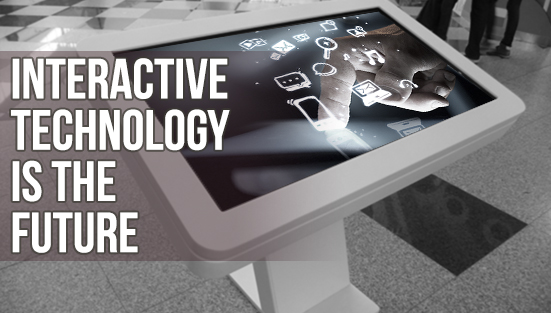Interactive technology is transforming the look of retail stores. This is not simply a battle between e-commerce and brick-and-mortar. This is the best of both worlds.
Top physical retailers are already using interactivity and data-rich content to attract modern customers and enhance their in-store experience. This includes the use of interactive mirrors, video, touchscreens, etc. to enhance the in-store experience for shoppers.
Just some examples:
• Apple embarks on the mobile wallet phenomenon
• Bloomingdale introduces smart fitting rooms with iPad devices.
• Ralph Lauren offers interactive shopping experiences with its window display
• Gucci sets an 'Infinity Flowers Wall' that lets shoppers interact with digital petals
A store is not just a place to make a purchase; interactive retail turns it into a place to have positive experiences. It creates a seamless customer journey so that customers will return even when they do not have a specific need in mind. Take a look at the future of interactive technology in the retail industry.
Interactive Wayfinding Directories
Customers do not want to waste time figuring out static maps; they want to quickly search a menu for what they need. They want a search engine which is simple and informative, giving them control over their experience. The reduction of shopping stress and anxiety increases the odds they will make purchases. Every business owner knows that a relaxed customer is a paying customer.
• On-Demand Touchscreens: Aside from being an indoor wayfinding map, retailers are using their digital screens to bring interactivity and engagement. Providing on-demand information to customers enhances their shopping experience.
The use of interactive self-service kiosks is already becoming popular in retail stores. They meet the customers demand interactive features and freedom when deciding to make a purchase.
As an example, Tesco tested touchscreen kiosks that allow customers to check stocks and order items. They also use interactive mirrors that enable customers to try clothes on 'virtually' using a gesture-based interface.
Mobile Functionality
Consumers are always on the go. No doubt, mobile smartphones are now the primary device for many, especially millennial and modern consumers. They are getting more sophisticated in using their gadgets - not just to research a product, check its price, or make comparisons. Consumers are using their devices for inspiration, idea-generation, and social interaction. An increasing percentage of customers base purchasing decisions on the reviews of other customers.
Mobile is not a channel, but an engaging relationship. Retailers need to understand what shoppers want and need from their gadgets.
• Mobile Searching: Consumers are using their devices to search for promotions, coupons, reviews, and the best deals. Retailers who are providing this information front and center are at the top of consumer's short attention span.
• Kiosks Integration: Major retailers have also invested in interactive directories that integrate with customers' mobile devices to deliver a seamless experience. Making information readily available every time a customer needs it.
• Beacons and georeferencing: Retailers are now using iBeacon and GPS technology to time personalized messages to shoppers.
For example, Walgreens Pharmacy stores have a detailed 3D view of their in-store maps. Shoppers who are using an app while navigating inside the store, or those near the store, receive notifications on discounts, offers, and other contextual information as they pass by.
• Personal Point of Sale (POS) Checkout: Mobile check-out apps significantly help reduce waiting time, providing convenience and enhancing customer service as well. It allows retailers to accept any form of payment with a mobile device anywhere. Checkout Kiosks are also commonplace.
As examples,
Some Wal-Mart stores have a Scan & Go app that allows users to scan merchandise and pay at a self-checkout counter.
Rebecca Minkoff store allows shoppers to check out through a mobile device. They can also scan clothing tags to receive complementary recommendations.
Nordstrom cut check-out queues down by using mobile POS devices in its stores to enable staff to check out customers anywhere.
Analytics
Obtaining records of online activities and other customer touch points allows business operators to understand the behaviors and desires of their customers. Analytics technology gives retailers the ability to identify and understand changes and drivers of customer behavior, among other things.
• Demographics: Customers information related to gender, age, income, etc. can easily be determined based on the retailer's scanning system.
• Daily customers: Retailers can also determine the number of clients entering the facility and the transactions made.
• Popular destinations: interactive technology makes it easy to track customer searches on interactive kiosks, mobile or website.
• Traffic flow: Marketers and staff can use information searches to determine the flow of traffic to an individual location by using the beacon tracking app or GPS tracking device.
• Conversion rates: Interactive POS and kiosk directories allow marketers to analyze the effectiveness of the promotion. It helps them identify the ads that generate the highest conversion rate. It is the easiest way to increase sales over time.
• Pooled Analytics: Analysis from multiple locations, segments and devices are now possible through interactive technology. Traffic reports, advertising results, consumer data and movement, marketing campaigns, etc. can be synchronized under one comprehensive report.
The demand for interactive technology in the retail industry cannot be stopped. This shift provides versatile, faster and efficient solutions that both customers and retailers benefit from.
For retailers to be successful in today's competitive environment, they should also embrace an omnichannel approach to catching up with the millennial. Modern day consumers want the best of the world in their terms and expect consistent and equally captivating experience across all channels. Businesses who can meet these needs, undoubtedly gain customers and more importantly, advocates.

